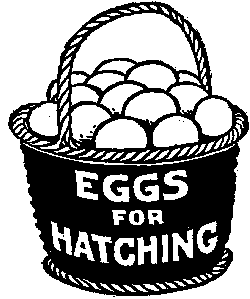 I DO NOT LIKE GREEN EGGS AND HAM
I DO NOT LIKE GREEN EGGS AND HAM
&
I'M NOT TOO CRAZY ABOUT THEORIES OF MORAL DEVELOPMENT, EITHER.
MORAL DEVELOPMENT & WHY I AM LESS THAN ENTHUSIASTIC
The three most influential theories of moral development are Kohlberg's, Gilligan's and Piaget's, probably in that order. I am fulfilling my moral obligation by discussing this because I know that these theories come up frequently in subsequent courses, and I do not want my students to look uninformed or poorly educated. That doesn't mean I have to like it.
An extremely brief introduction to theories of moral development.
All of these are covered in your textbook, so I would just like to review some highlights:
1. All focus primarily on moral REASONING, not moral BEHAVIOR.
In other words, all of these theories are principally concerned with how
children (or adults, for that matter) make judgements about what is right
or wrong, and not on what people actually do.
| 2. Where one scores on a measure
of moral reasoning is NOT a very good predictor of moral behavior. That
does make sense, really. Everyone who has ever done anything they knew
was wrong, please raise your hand now. Just because you are able to JUDGE
correctly whether something is moral or not does not mean you necessarily
are going to do the thing you know is right.
Those of you who did not raise your hand are lying. That is immoral. |
 |
3. Moral behavior is not consistent across situations. A student who cheats on a test may be the same person who would never, ever in a million years steal something from a friend's house. Moral behavior is not simply NOT doing what is wrong, but also doing what is right. Prosocial behavior is the term commonly used to refer to actions such as sharing, helping another person, etc. This is also not very well predicted from stages of moral reasoning. It is also not measured by Kohlberg's methods. From my experience, if such prosocial behaviors as sharing and helping were included, Native Americans as a group would have scored a great deal higher on moral development than do middle-class white males (but be sure to read point #6 below).
4. Piaget looked at children's understanding of RULES and thought that children progressed from judging good and bad by CONSEQUENCES to judging based on INTENTS. So, to a small child, if you broke something or hurt someone, that was bad, whether you meant to do it or not. Rules are absolute. If Evelyn tripped and hit another person, she still broke the rule against hitting another person and must be punished. By the end of middle childhood, children have generally progressed to judging based on intent. In the same situation, older children will say that Evelyn didn't intend to hit anyone, and should not be punished.
5. Kohlberg thought moral development occurred in three stages, preconventional, conventional and postconventional, each of which had two substages. He used moral dilemmas to assess children's (and adults') levels of moral reasoning.
6. Kohlberg believed that his stages were universal and that everyone went through them in the same sequence, although not everyone reached the final stage. In group comparisons of ratings using Kohlberg's methods, boys and men are superior in moral development to girls and women, and white middle and upper-middle class males from the United States and European countries are apparently the most morally developed bunch on earth, because they tend to score higher than people who are poor or from less developed countries.
7. Gilligan thought that women's moral development was not inferior or slower than men's, but different. She said that while men tend to make judgements based on their view of justice, women tend to make decisions based on relationships. For example, a man might argue that, since the woman had chosen what movie they went to the last two times, it was his turn to go see the Ax-Murderer who Killed Everyone in New York (and, no, don't email me and ask where it is playing). In the same situation, however, the woman might just go along to his choice of movies for the third time in a row, because it is important to him, she values his feelings, and she is just going to sleep through it, anyway.
8. Gilligan said that girls progress from "Caring for self", to "Caring for others" to "Caring for self and others". In one practical application of her theory, some family therapists refer to the "Empty Pitcher Syndrome" where a woman is constantly 'pouring it out', taking care of the physical and emotional needs of others, and not putting anything back into herself in terms of what she needs, and one day, there is just nothing left to give. The pitcher is empty.
9. Carol Gilligan's most famous book is In a different
voice, and one good thing I will say about her theory of moral development
is that she has inspired reflection on the part of many, many writers,
particularly in such fields as the Psychology of Women. She is one of the
first people to make the case that women are something other than soft
(or defective) men, and to get a substantial number of others to actually
pay attention to that assertion. If the "goodness" of a theory is judged
by the amount and breadth of additional research and inquiry it inspires,
I would say hers will probably win out of the three. There! I said something
good about a theory of moral development. Are you happy now?
Try this with your friends.
ALLIGATOR RIVER
(I read this in a teachers' guide, which I no
longer have. Anyone who knows the author, please send it to me. I looked
on the Internet but all I found out is that there are a lot of wildlife
parks named Alligator River.)
Abigail and Michael are two young lovers engaged to be married. Michael lives on an island in the middle of a river infested with alligators. There is a bridge to the shore that he and Abigail use to get together. One night, a terrible storm blows a tree over on to Michael, breaking his leg. It also washes out the bridge. Michael, screaming in pain, asks Abigail to help him. She goes to Abner, who has the only boat around, and asks to be ferried across the river. He says, "Only if you have sex with me." Abigail turns him down, and asks another friend of hers, Glen, if he can try to talk to Abner, but Glen says he doesn't want to get involved. With no other way to help Michael, Abigail has sex with Abner. They then go to the island, get the tree off of him and get him to a hospital. When he finds out what she has done, Michael breaks off their engagement. Abigail is sobbing and Sluggo comes and asks her what is the matter. She tells him the whole story and he goes and beats up Michael. As the story ends, Michael is once more in pain and Abigail walks off into the sunset laughing at him.
The exercise is:
List the participants in the story, Abigail, Abner, Glen,
Michael and Sluggo in order from the least moral to the most moral person,
and give your reasons for doing so. Email
me your answer.
My younger daughters said you could never use this example in school and were quite shocked, because, they said, "It talks about sex." So, they would be considered at the stage of viewing rules as absolutes.
My oldest daughter said that it was too confusing, and that the Heinz one was easier to remember. Which brings up another point to ponder-- is moral development related to cognitive developmet. Well, moral reasoning is, yes, with people in the higher stages of moral development always in the higher stages of cognitive development (although not necessarily the other way around.)
 |
BROADEN YOUR HORIZONS Bonus links - explore a little, broaden your mind. The links below are not specifically related to moral development, are somewhat related to middle childhood, somewhat more related to developmental psychology and psychology in general. |
ENRICHMENT ACTIVITIES
Misremembering childhood. What we sincerely believe our childhood was like may never have happened. Elizabeth Loftus on false memories.
Memory links -- If you want to look at pictures of brains, read articles on memory and memory strategies
To see a sheep's brain dissected go here.
Both of these, by the way, come to you courtesy of the
Museum of Science, Art and Human Perception website. The museum is located
in San Francisco, but they have a great web site, particularly for middle
childhood, because much of it is focused on activities which are related
to concrete experiences - such as learning the anatomy of memory by looking
at an actual brain. This is appropriate because, during middle childhood,
children are in the CONCRETE OPERATIONAL STAGE. You knew I would get back
to the topic sooner or later, didn't you?
 |
More of the same old stuff
Click here to go to the next section of the course on social development in middle childhood. |